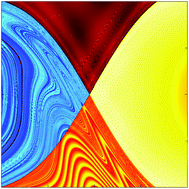Lagrangian descriptors in dissipative systems
Abstract
The reaction dynamics of time-dependent systems can be resolved through a recrossing-free dividing surface associated with the transition state trajectory—that is, the unique trajectory which is bound to the barrier region for all time in response to a given time-dependent potential. A general procedure based on the minimization of Lagrangian descriptors has recently been developed by Craven and Hernandez [Phys. Rev. Lett., 2015, 115, 148301] to construct this particular trajectory without requiring perturbative expansions relative to the naive transition state point at the top of the barrier. The extension of the method to account for dissipation in the equations of motion requires additional considerations established in this paper because the calculation of the Lagrangian descriptor involves the integration of trajectories in forward and backward time. The two contributions are in general very different because the friction term can act as a source (in backward time) or sink (in forward time) of energy, leading to the possibility that information about the phase space structure may be lost due to the dominance of only one of the terms. To compensate for this effect, we introduce a weighting scheme within the Lagrangian descriptor and demonstrate that for thermal Langevin dynamics it preserves the essential phase space structures, while they are lost in the nonweighted case.

- This article is part of the themed collection: Insights from advanced methods in molecular dynamics


 Please wait while we load your content...
Please wait while we load your content...